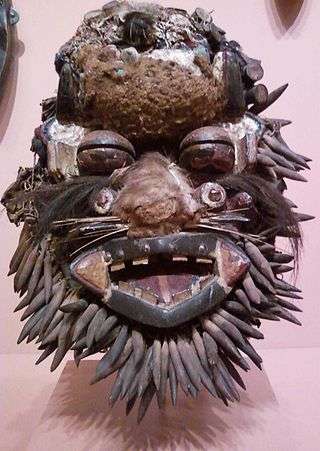Krahn people
|
Photograph of a Kru woman in Liberia taken in 1906 by Sir Harry Hamilton Johnston.[1] | |
| Total population | |
|---|---|
| 214,000 | |
| Regions with significant populations | |
| 116,000 | |
| 98,000 | |
| Languages | |
|
Niger–Congo Atlantic–Congo Kru Western Kru Wee Guere–Krahn Guéré | |
| Religion | |
|
Primarily: Ethnic religions • Ivory Coast:[2] Christianity (<5%) Evangelical (3%) • Liberia:[2] Christianity (>5%) Evangelical (3.5%) | |
| Related ethnic groups | |
Krahn is an ethnic group of Liberia and Ivory Coast. This group belongs to the Kru language family and its people are sometimes referred to as the Wee, Guéré, Sapo, or Wobe.[3] It is likely that Western contact with the Kru language is the primary reason for the development of these different names.[4] The term Krahn may also be applied to denote the language spoken by this ethnic group.
History
The Krahn arrived in the area known as Liberia previously known as the "Green Coast" as part of early sixteenth century migrations from the north-east and what is now the Ivory Coast.[5] This migration occurred due to pressure on local populations resulting from an emigration of Western Sudan tribes after the decline of medieval empires, as well as an increase in regional tribal wars.[6] During this timeframe, the African slave trade was becoming more prominent within Liberia. Although some Kru tribes faced capture by Westerners, it was more common for the Krahn and other coastal peoples in Liberia to serve as local traders, brokering deals within the Western slave market. The Kru were so opposed to slavery within their own tribe members that many committed suicide rather than face enslavement.[6][7]
Liberian Civil Wars
During the late 1970s Liberia faced a heated civil war in which opposition to the Americo-Liberian and Tolbert government, led to a military coup, organized in part by indigenous tribal members. The culmination of this coup came on April 12, 1980 when Krahn leader, Master Sergeant Samuel Kanyon Doe seized power, becoming the first native leader and Head of State.[8] With a Krahn leader serving as a key political figure, the once disparaged and "uncivilized" Krahn were now given a place of honor within Liberia’s governing body.[5] This rise in status led to many Krahn speakers moving from coastal and inland areas to the capital, Monrovia. In time, Doe began showing favoritism to the Krahn, particularly to those from his own tribal group. These measures included appointing members of the Krahn’s ethnic kin in Ivory Coast, known more commonly as the Wee, to the Executive Mansion Guard, as well as taking steps to prevent non-Krahn individuals from reaching key government positions.[5]
By 1985 Doe’s fierce response to his opposition created a large contingent of “anti-Doe” supporters.[8] In December 1989, exiles and local recruits began organizing military groups, resulting in another civil war, this time against Doe and his Krahn supporters. As this war progressed, the National Patriotic Front of Liberia (NPFL) began attacking Krahn civilians in Nimba and Grand Gedeh Counties, destroying entire communities as they moved through the country.[5][8] By mid-1990, the war had escalated, prompting foreign intervention. Unfortunately for Doe, this intervention was not to play in his favor, culminating in his kidnapping and execution by opposition forces. Following the removal of the Doe regime, and the continuation of the civil war, Krahn refugees began fleeing from Liberia to Ivory Coast, some taking the Krahn language with them. It was during this time that the sarpo, who are a member of the Krahn Speaking Group, begin to call themselves Sarpo because of fear, but Sarpo is one of the krahn Speaking group.[8]
Recent history
Although Doe was removed from power in 1990, the civil war did not officially reach its end until 1996, at which time Charles Taylor ran for presidency, winning the 1997 general election amidst much controversy.[9] This presidency was not well received by all groups however, and in 2003, members of the Krahn tribe founded a rebel group, the Movement for Democracy in Liberia (MODEL), as a means of fighting a war against Taylor. The group has since promised to disband as part of its initial peace agreement.[5]
Today Liberia’s government is far more stable, which has in turn allowed the Krahn to resettle throughout the nation. Present day Krahn are typically found within Nimba, and the Grand Gedeh and Sinoe Counties, as well as Ivory Coast.[10]
Culture
The Krahn in Liberia were originally hunters, farmers, and fishermen, traditionally focusing on rice and cassava production. The land in this region has faced developmental setbacks and as a result, many of the younger Krahn generations have migrated to areas such as Monrovia.[5] The Wee in Ivory Coast also traditionally became hunters, farmers, and fishermen, but they tended to focus more heavily on crops such as "rice, yams, taro, manioc, maize, and bananas."[11] Like the Krahn in Liberia, the Wee traditions of hunting and farming have faced some difficulties, and in more recent years many have instead begun laboring in diamond camps and on rubber plantations.[11]
Early political structures

Early Krahn political organization was traditionally decentralized in both Liberia and Ivory Coast.[5] The tribes often lacked a central governing power, instead turning to a village "headman" who rose to a position of social esteem through skill, hard work, and luck in hunting and farming. These individuals often formed councils consisting of young warriors for protection and village elders to serve as consultants in village affairs. This governing group would broker trades with neighboring tribes, as well as make important decisions for the tribe members.[11] Within these tribal groups, it was not uncommon for ceremonial face masks to serve dual roles in rituals and politics. These masks were often modeled after fearsome animals and were utilized in community mediations. They may also have been a means of implementing social control in the years prior to adoption of Western laws during the colonial period.[13]
Religion
Many Krahn believe that objects have spirits or souls (animism). An example of this is seen in several Kru artifacts found in 1979 near Maryland County, Liberia.[14] Although scholars are not certain of their origins and intended use, some sources believe that the Kru saw these objects as living entities typically found in small bodies of water such as rivers and creeks. Called 'tien','nitien' or 'Dwin,' these artifacts would have been viewed as water spirits or 'Gods of water.'[15] Additionally, it is believed that powers associated with these beings included healing, fertility, and the ability to end conflict and create new villages. The Kru also thought that a town or village could gain protection from one of these water guardians if they were caught in the water and carried into town.[15]

According to the Wee of Ivory Coast, it is also believed that the natural world is made up of spirits, referred to as “bush spirits.”[11] These spirits are part of the world untouched by man, and the Wee believe that keeping these spirits appeased is vital to the health of the tribe. Whenever new land requires cultivating for fields or expansion, or when tribesmen needed to venture outside the village, it becomes necessary to make offerings to the spirits, with such endeavors being surrounded by an air of danger. It is further believed that the bush spirits take corporeal form in order to interact with the villagers and participate in ceremonies.[11] The Wee feel that the bush spirits can communicate with humans through dreams, often demanding ceremonial masks be created in their honor in either male or female forms. These masks then serve a variety of functions ranging from ritual ceremonies, forms of entertainment, and focal points in moral stories to judicial and political controls. Typically, female masks are viewed as less imposing and more beautiful than male masks and are in turn used more for ritual and entertainment purposes, while the male masks are often more ferocious-looking and serve roles in sociopolitical issues. That said, all Wee masks are believed to deflect sorcery attacks, and many undergo shifts in their primary function during their lifetime.[17]
Language
Krahn is one of the Kru languages which belongs to the Niger–Congo language family. Although many Kru-speaking tribes have adopted English as their second language, recent studies have shown that Kru is still spoken by many Liberians. Within the Kru language there are several subcategories, with Eastern and Western Kru offering the first significant division of tribal language breakdowns. This Kru language chart clearly shows that Krahn falls under the Western Kru, Wee subgroup. Some scholars further denote a difference between Eastern and Western Krahn, with Eastern variations typically spoken in northeast Liberia and Western Krahn spoken throughout Grand Gedeh County and Ivory Coast. As of 1993, there were approximately 47,000 Eastern Krahn speakers within Liberia, with an additional 47,800 Western Krahn speakers in Liberia and 12,200 in Ivory Coast.[18] [19]
See also
Footnotes
References
- ↑ Johnston, Harry Hamilton (1906), Kru Woman 2, retrieved 17 May 2012
- 1 2 Joshua Project (n.d.), Krahn, Western of Cote d'Ivoire, retrieved 16 May 2012
- ↑ Library of Congress (2004), Krahn (African people), retrieved 16 May 2012
- ↑ Holsoe, Svend E.; Lauer, Joseph J. (Apr 1976). "Who Are the Kran/Guere and the Gio/Yacouba? Ethnic Identifications along the Liberia-Ivory Coast Border". African Studies Review. African Studies Association. 19 (1): 139–149. doi:10.2307/523856. JSTOR http://www.jstor.org/stable/523856.
- 1 2 3 4 5 6 7 Minority Rights Group International (2005), Liberia Overview, retrieved 17 May 2012
- 1 2 van der Kraaij, Fred P.M. (1983), The Open Door Policy of Liberia – An Economic History of Modern Liberia, Bremen: Im Selbstverlag des Museums, pp. 1–5
- ↑ Johnston, Harry H. (1906), Liberia, New York: Dodd, Mead, & Company, p. 110
- 1 2 3 4 Mackinlay, John; Alao, Abiodun (1995). "Liberia 1994: ECOMOG and UNOMIL Response to a Complex Emergency". Occasional Paper Series 2. Tokyo, Japan: United Nations University. Retrieved 17 May 2012.
- ↑ Onishi, Norimitsu (7 December 2000). "In Ruined Liberia, Its Despoiler Sits Pretty". The New York Times.
- ↑ Lewis, Paul M. (Ed.) (2009), 2009. Ethnologue: Languages of the World (16th ed.), Dallas, TX: SIL International, retrieved 16 May 2012
- 1 2 3 4 5 University of Iowa (1998), We Information, retrieved 17 May 2012
- ↑ The Indianapolis Museum of Art (2012), Face Mask, retrieved 11 May 2012
- ↑ Michael C. Carlos Museum of Emory University (n.d.), Bush Cow Mask, retrieved 16 May 2012
- ↑ "Ritual object or 'Kru money'?". Liberia Past and Present. Retrieved 19 May 2012.
- 1 2 Siegmann, William C.; (as cited in) van der Kraaij, Fred P.M. (1977). Rock of the Ancestors: namôa koni. Suakoko, Liberia: Cuttington University College. Retrieved 17 May 2012. Cite uses deprecated parameter
|coauthors=(help) - ↑ National Museum of African Art (2008), Krahn Mask, retrieved 17 May 2012
- ↑ Curnow, K. (n.d.), African Art, retrieved 17 May 2012
- ↑ Grimes, Barbara F. (1996). Ethnologue (13th ed.). Summer Institute of Linguistics, Inc. Retrieved 17 May 2012.
- ↑ Olukoju, Ayodeji (2006). Culture and Customs of Liberia. Westport, CT: Greenwood Press. Retrieved 17 May 2012.

